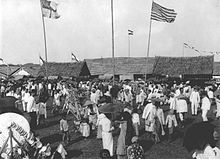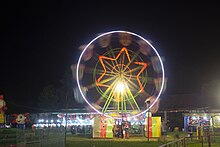Pasar malam
[4] The pasar malam may be held in a fixed location or itinerant, offering a variety of products such as street food, snacks, desserts, produce, apparel, accessories, handmade crafts, houseware, gadgets, toys, knick-knacks, and ornaments at cheap or reasonable prices.The most notable one is Pasar Gambir, a night market fair held in 1906 and yearly from 1921 until the outbreak of World War II in 1942, in the Koningsplein, Batavia, Dutch East Indies (now Merdeka Square, Jakarta, Indonesia) to celebrate the birthday of Queen Wilhelmina of the Netherlands.[7] In Java, especially in the Javanese royal cities Yogyakarta and Surakarta, the grand week-long pasar malam is usually held annually during the Sekaten festival to celebrate Mawlid, or the birthday of Muhammad.Today, several kecamatan (districts) in Jakarta and also other provinces in Indonesia, hold weekly pasar malam, usually every Saturday night in a nearby alun-alun square, open fields, or marketplaces.Some of the most notable ones include: In Malaysia, Pasar Malam is normally set as a temporarily closed street for vehicles and open for pedestrians from evening until late night weekly.[14] Present-day pasar malams are organised at specific locations on a temporary lease, usually before festive occasions such as Lunar New Year, Hari Raya Puasa, and Deepavali.






RawasariCentral Jakartanight marketbazaarPersianstreet marketIndonesiaMalaysiaBruneiSingaporeChatuchak MarketShilin Marketstreet foodsnacksfairgroundcarouselcotton candyice creamhot dogsHagglingDutch East IndiesJavaneseSekatenRamadhanLebaranLunar New YearBataviaTan Eng Goan, the 1st Majoor der ChineezenlightbulbsPasar GambirWorld War IIMerdeka SquareQueen Wilhelmina of the NetherlandsJakarta FairDen HaagTong Tong FairFerris wheelYogyakartaSurakartaMawlidMuhammadJakartakecamatanalun-aluncarouselsPalembangMusi RiverpempekGadongBandar Seri Begawantraditional Bruneian dishesNasi KatokJurong EastSeri KembanganSelangorPeople's AssociationNetherlandsIndo-EurasianThe HagueHawker centreKopi tiamMarket (place)Pasar pagiWet marketFarmers' market